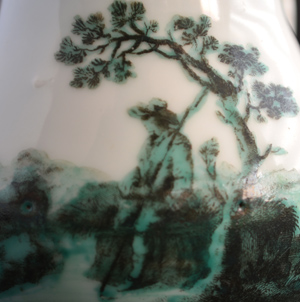
YONGZHENG 1723 – 1735 English Transfer Printed and Painted
A Rare English Transfer and Enamel Decorated Yongzheng Cream Jug c.1730. The White Chinese Porcelain Teapot with English Transfer Prints and Green Enamel Decoration Added c.1755-1758, Probably in the Midlands. The Scene Depicted is of a Rustic Landscape with a Shepard Casually Watching His Flock While Seated Under a Tree.
SOLD
- Condition
- The cover is lacking, some crazing and associated satining to the handle.
- Size
- Height : 8.5 cm (3 1/4 inches)
- Provenance
- Antiquaire Simonet-Bruzelles 16th April 1945. Monsieur and Madame Robert de Strycker : The Belgium couple Professor Robert de Stryker and his wife discovered Chinese art during a visit to London in the 1930`s. In 1938 they started to collect, porcelain, cloisonné, prints and lacquer, amassing a large and interesting collection with objects from the Neolithic period to the Qing dynasty. Fortunately the provenance of most of the pieces in the collection have been recorded with details the date of purchase, the name of the gallery or shop they were purchased from as well as the price paid. The De Strykers had a great passion for what they purchased but also an academic approach to their subject. Professor De Stryker exchanged a large number of letters with Harry Garner and Fritz Low-Beer as well as establishing a close relationship with the Curator of the Guimet Museum in Paris. Some pieces in their collection where shown in the exhibition `Oudekunst in Leuvensprivebezit`, this ran from July 18th to October 18th 1964.
- Stock number
- 24144
- References
- For a Chinese export porcelain teapot with this design see : The Watney Collection of Early English Porcelain, Part II. May 10th 2000. Phillips Bond Street, Lot 448. The catalogue states "This rare print resembles `Smoky Primitive` prints on Worcester porcelain datable to the mid-1750`s although so far it has only been recorded on Chinese porcelain. For a cream jug in this design see : Oriental Export Market Porcelain and its Influence on European Wares (Geoffrey A. Godden, Granada, 1979.ISBN 0246110570) page 371, plate 288. Geoffrey Godden notes that It is strange that the print has not yet been recorded on English porcelains-only Chinese. For a teabowl and saucer from E & H Manners see : European Decoration on Oriental Porcelain 1700 - 1830 (Helen Espir, Jorge Welsh Books, 2005) page 237, plate 41. Helen Espir suggests that it was probably decorated in the Midlands. For a Yongzheng Mark and Period Teabowl 1723-1735 with this design and coloured enamels see our `Sold Items` number 23654. A small group of this transfer printed and enamelled design is illustrated in : The Early James Giles and his Contemporary London Decorators (Stephen Hanscombe, Stockspring Antiques. 2008) page 150, plate 153.
Information
English transfer decorated Chinese export porcelain is one of the rarest groups of over-decorated porcelain. It is interesting to note that this early print has not been found on English porcelain, the addition of enamel is also highly unusual. The form of the teabowl as well as the quality of the paste point to the porcelain being the same as the mark. None-Imperial Kangxi mark and period porcelain is common but large numbers of none-imperial Yongzheng mark and period also exist. Pieces with four character Yongzheng marks were recovered from the `Ca Mau Cargo`.
Plain white 18th century Chinese export porcelain is rare, however there are many pieces from the 1750`s and 1760`s that were plain, then decorated in London enamelling workshops. So it seems likely they were part of specific orders of white porcelain solely for decoration in England. However the present example relates to a teabowl with a six character mark of Yongzheng (1723-1735), so it appears this piece in the West for some time before it was decorated.